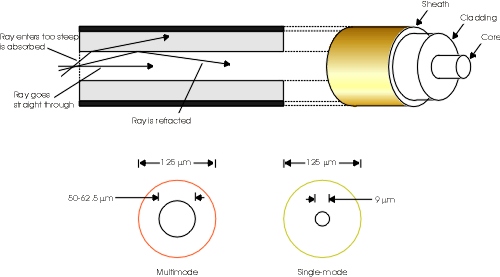Fiber Optic Cable
- Uses light instead of electricity to transmit signals
- Fiber is glass or plastic
- Light source is laser or LEDs
- Can transmit huge distances compared to copper cable
- No EMI, hard to intercept
Fiber optics
Single Core.A data transmission medium consisting of glass or plastic fibers. Light-emitting diodes (LEDs) or lasers send light through the fiber to a detector, which then converts the light back into electrical signals. Fiber-optics offer immense bandwidth, as well as protection from eavesdropping, electromagnetic interference, and radioactivity. Fiber-optic cabling employs one or more optical fibers, consisting of a central glass or plastic fiber, glass cladding, and a plastic outer sheath. Fiber-optic cable carries information as light instead of electricity, and can carry much more information over greater distances than copper cabling.
Optical principles
Fiber can transmit light a long distance because it keeps it in a channel. This is accomplished by surrounding the inner fiber with a cladding that has a different refractive index. This keeps the light bouncing along from side to side until the end.

Figure 21: The structure of fiber optic cable
Single-mode cable
Single mode cable only has one light beam in it. The cable has a small diameter core and is made of the purest glass. A laser is usually the light source and the cable can extend several kilometers without a repeater.
Multimode cable
Multimode cable has greater capacity because several light beams are sent down it. The beams enter at slightly different angles and therefore don’t interfere with each other. The core is wider than used in single-mode and often made of fine plastic. Instead of lasers, the light source is usually light emitting diodes (LEDs). The system has greater capacity and is less expensive than single-mode. On the other hand, multimode doesn’t have the same reach, often restricted to hundreds of meters instead of kilometers. For this reason, multimode is usually used inside buildings, whereas single-mode is used between buildings and long distances. If the cable needs to be extended, optical repeaters are used.
Pros and cons
Fiber optic cable has the longest range and should be used when long distance is a requirement. It has extremely high bandwidth, in the Gbps range. It is also immune to electrical interference, nor does it give off any of its own. This would be a factor in dangerous environments where an electrical spark could set off an explosion, say in an explosives factory. Finally, it is extremely difficult, but not impossible, to tap into a fiber optic system.
Connectors used for fiber cable are SC connectors which are a push and pull connector and ST connectors which are a bayonet mount.
No comments:
Post a Comment